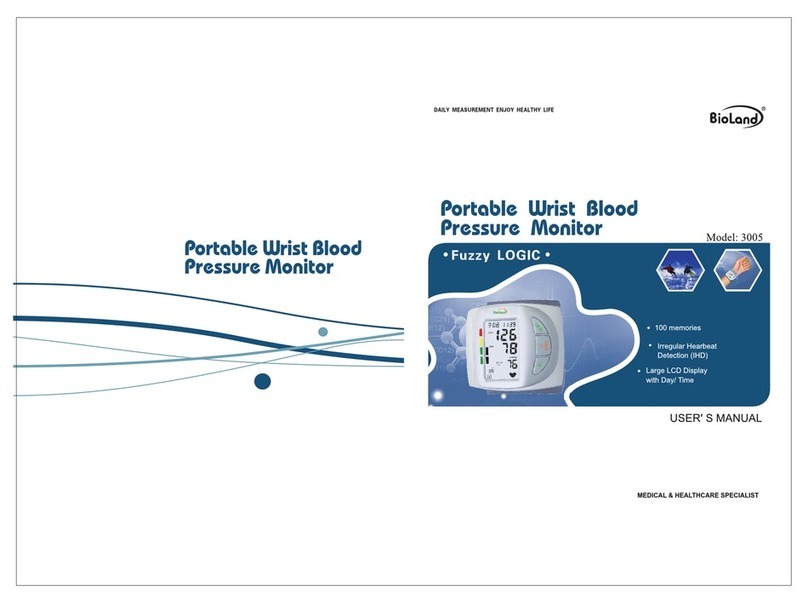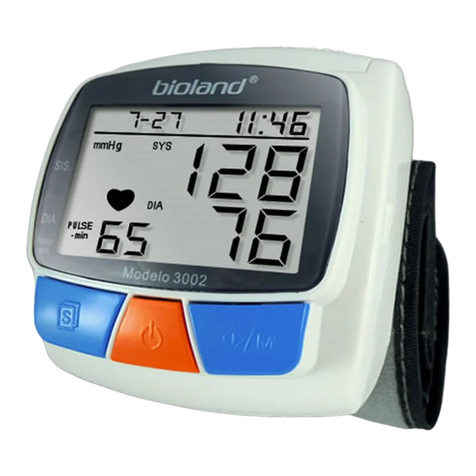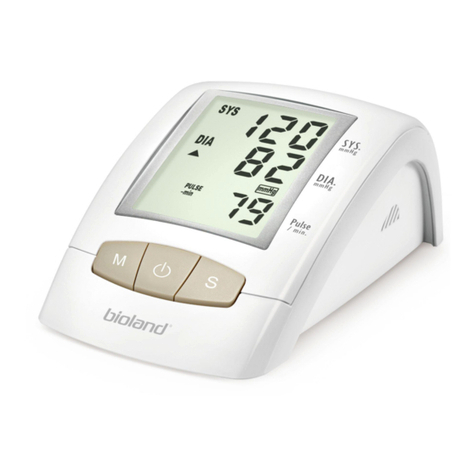Bioland 2005 User manual

INSTRUCTION MANUAL
UPPER ARM AUTOMATIC
BLOOD PRESSURE MONITOR
Model: 2005
22-32-cm
2~3cm
TYPE:ACMNP-1
POWER
START
Blood Pressure Monitor

-1- -2-
INTRODUCTION
Thank you for purchasing the upper arm Automatic Blood Pressure Monitor. This
remarkable instrument is ideal for people who frequently monitor their own blood pressure
because it's easy to use. Simply push of a button the monitor measures your blood
pressure and pulse and displays the reading on a clear digital panel. Perfect for quick, easy
readings at home, at work, almost anywhere!
The Monitor uses the oscillometric method of blood pressure measurement. This means
the monitor detects your blood's movement through the artery in your arm and converts the
movements into a digital reading. An oscillometric monitor does not need a stethoscope so
the monitor is simple to use and measurements are easy to obtain.
Clinical research has proven a direct relationship between blood pressure in the wrist and
blood pressure in the arm. Changes in wrist blood pressure reflect changes in arm blood
pressure because the arteries in the wrist and the arm connect. Frequently measuring the
blood pressure in your arm will provide you and your doctor with an accurate indication of
changes in your actual blood pressure.
The product complies with the electromagnetic compatibility requirement of EN60601-1-2
and safety standards of 60601-1 as specified in EEC directive 93/42/EEC.
Please read this instruction manual thoroughly before using the upper arm Automatic Blood
Pressure
Monitor. For specific information on your own blood pressure, CONTACT YOUR
DOCTOR.
NOTES ON SAFETY
*The warning signs and sample icons shown here are listed for your safe
and correct use of the unit, so as to prevent injuries or damages to the device.
*The icons and meanings are as follow.
TABLE OF CONTENTS
Introduction ..........................................................................................................................2
Notes on safety ...................................................................................................................2
A Few Words About Blood Pressure ....................................................................................3
Precautions Before Use ........................................................................................................6
Features of the Product .......................................................................................................6
Main Unit .............................................................................................................................7
Insert or Replace Batteries ..................................................................................................7
Time and Date of System Setup .........................................................................................8
How to Use the Upper Arm Cuff ...........................................................................................8
A Few Suggestions Before Measurement .........................................................................10
How to Measure Blood Pressure .......................................................................................10
Recalling Record ................................................................................................................12
How to Maintain and Store the Unit ....................................................................................12
How to Prevent a Malfunction .............................................................................................13
Specifications .....................................................................................................................13
Troubleshooting ................................................................................................................. 14
The icon indicates prohibitions (what you should not do).
Matters involving actual prohibitions are indicated by text or pictures in or
near . The left icon refers to "general prohibition".
The icon indicates something that is compulsory (What must always be observed).
Matters involving actual compulsory actions are indicated by text or pictures in
or near . The left icon refers to "general compulsion".
Type BF Applied part
Attention and read before use
Examples of signs

-3- -4-
Caution
Self-diagnosis of measured results and treatment are dangerous. Please
follow the instructions of your doctor.
Self-diagnosis may worsen the disease.
Do not use the unit for infants or person who cannot express one's intention.
May cause accident or trouble.
Do not use the unit for purpose other than measuring blood pressure.
May cause accident or trouble.
Do not use cellular phone near the unit.
The main unit may operate erroneously.
Do not disassemble, repair, or remodel the main unit or the cuff of the blood
pressure monitor.
Will cause the unit to function erroneously.
Requests from Manufacturer
Used batteries may leak and damage the main unit. Please observe the following points.
*If you are not going to use the unit for a long period of time (approximately three
months or more), remove the batteries.
*Replace worn batteries with their polarities in the correct direction.
*Do not insert the batteries with their polarities in the wrong direction.
Do not use force to bend the cuff or the air tube.
When removing the air tube, please pull and hold at plastic plug.
Do not knock or drop the main unit.
Do not inflate the cuff when it is not wrapped on the upper arm.
Always use the specified accessories in the manual, the use of other parts not
approved by the manufacturer may cause faults or injuries.
For service information , parts list etc., please contact the dealer.
A FEW WORDS ABOUT BLOOD PRESSURE
Blood pressure is the force exerted on the walls of your blood vessels as blood flows
through them.
Your heart is like a pump. When it contracts,
or beats, it
sends a surge of blood through the blood vessels and
pressure increases. This is called your systolic
pressure.
When your heart relaxes between beats, your blood
pressure decreases. This is called your diastolic
pressure.
When a doctor takes your blood pressure,
he or she
measures both your systolic and diastolic pressures
and records them as numbers. For example, if your
blood pressure reading is 126/76 (126 over 76), your
systolic is 126 and your diastolic is 76. The numbers
are calculated in millimetres of mercury and recorded
as 126/76 mm Hg.
These two numbers provide important information
about your health. The more difficult it is for your blood
to flow through your blood vessels, the higher both
numbers will be. When blood pressure is consistently above normal it is called
hypertension (High blood pressure).
The Blood Pressure Monitor automatically measures your systolic and diastolic blood
pressure for you, then displays the results on easy-to-read digital panel!
People with a condition that causes circulatory problems (diabetes,
kidney disease,
arteriosclerosis, or poor peripheral circulation) may get lower readings with wrist type
monitor than with a blood pressure monitor that is used on the upper arm. Please consult
your physician to determine if your wrist blood pressure accurately reflects your actual
blood pressure.
Your blood pressure changes constantly. Blood pressure fluctuates
from day to day and
minute to minute according to your body's needs. For example, when you are exercising or
angry your blood pressure increases, but when you are relaxing or sleeping
your blood
pressure decreases. These fluctuations are completely
normal. This blood pressure monitor
is especially helpful when tracking changes in your blood pressure because it takes just
seconds to use.
Heart Contracts
(Pressure Increases)
Heart Relaxes
(Pressure Decreases)
Systolic
(Upper Number)
Diastolic
(Lower Number)

-5--6-
Note: There is not an universally accepteddefinition of hypotension (low blood pressure),
but a systolic pressure below 99 mmHg is usually regarded as hypotension.
PRECAUTIONS BEFORE USE
1. Do not confuse self-monitoring with self-diagnoses. Blood pressure
measurements should only be interpreted by a health professional who is familiar with
your medical history.
2. If you are taking medication, consult with your doctor to determinethe
mostappropriate time to measure your blood pressure. NEVER change aprescribed
medication without first consulting with your doctor.
3. For people with irregular or unstable peripheral circulation problems due
to diabetes, liver disease,hardening of the arteries, etc., there may be fluctuation in
blood pressure values measured at the upper arm versus at the wrist.
4. This device is designed for adults to use .If use this device ona child patient, old people
or toddlers, consult with your doctor or measure with relative aid.
5. Measurementsmaybeimpairedif this deviceis usedneartelevisions,microwaveovens,
X-ray,mobile phone equipmentor other devices with strong electrical fields.To prevent
such interference, usethe meter at asufficient distance from suchdevicesorturnthem
off.
6. This deviceis not suitable for disease diagnoses, urgenttreatment,continuousmonitoring
during medical emergencies or operations.
7. Before using, should washyour hands.
8. Ifthere istoo much pressure or you feel uncomfortable, please press"POWER" button
immediately for quickdeflation.
FEATURES OF THE PRODUCT
1. Uses the fuzzy-logic measurement.
2. Memorycan store128 measurements.
3. Easyto use buttons.
4. Large and clear display.
5. Upper arm cuff is easy to wrap correctly.
6. Desktop style for easy measurement.
7.Easyto use, Pressa button to automatically measure, recording the measurement
valuesand measurement time.
8.Automatically turns off (within 2.5minutes)to save power.
Note: One or two readings will not provide a true indication of your normal blood pressure.
Itisveryimportanttotakeregular,dailymeasurementsandtokeepaccurate
records.In partnership with your doctor,an accurate record of your blood pressure
over a period of timecan be avaluable aid indiagnosing and preventing potential
health problems.
TheWorldHealthOrganisation(WHO)developedthefollowingBloodPressure
Classification.Thisclassification,however,isonlyageneralguidelinebecauseblood
pressurevariesfromperson topersonaccordingtoage,weight,andhealthstatus.
CONSULTYOUR DOCTOR TO DETERMINEYOUR NORMAL BLOOD PRESSURE.
Fluctuation Within a Day
(Example: 35-year old male)
0
5 pm
Time
11 pm 5 am 11 am 5 pm
50
100
150
200
250
300
Dinner Sleeping Lunch
Systolic
Blood pressure
Diastolic
Blood pressure
Blood Pressure (mm Hg)
Breakfast
FACTORSTHAT MAYCAUSE THE BLOOD PRESSURE TO FLUCTUATE
*Breathing*Exercise *Mental stress *Worries *Environmental and/or
temperature change *Eating *Urination and bowel movement *Talking *Taking
a bath *Drinking alcohol *Smoking, etc.
95
mm Hg
Hypertension
Borderline
Normal
140 160 mm Hg
90
Diastolic
WHO Blood Pressure Classification
Systolic
Normal
Borderline
Hypertension
Systolic (mmHg)
less than 139
140 to 159
more than 160
Diastolic (mmHg)
less than 89
90 to 94
more than 95

-7- -8-
MAIN UNIT
7. POWER Button
1. Air Tube Hole 8. START Button
2. Blood pressure Display 9. Button (UP) For memory recall and
3. Date and Time Display Date / Time adjust
4. Systolic Value 10. Button (DOWN) For memory
5. Diastolic Value recall and Date / Time adjust
6. Pulse/min Value 11. SET Button
12. Upper Arm Cuff
13. Air Tube
INSERT OR REPLACE BATTERIES
During the battery symbol appears on the display or nothing is display while inflation during
measurement, you should replace with new batteries.
1. Slide the battery cover in the direction of the arrow to open.
2. Insert four "AA" alkaline batteries in the correct polarity direction.
5. When the battery icon displays on the LCD, please replace four new alkaline
"AA"
batteries, please do not mix the new and old battery together.
6. If the unit will not be used for a long period, please take out all batteries to avoid liquid
leakage
damaging the unit.
TIME AND DATE OF SYSTEM SETUP
1. Press "POWER" key to turn on.
2. Press and hold "SET" key until the year number displays and flashes on LCD to enter
setting mode.
3. Press" " or " " key to adjust the year, then press " SET " key
again to save your setting and enter the
month setting mode.
4. Press " " or " " key to adjust the month.
Following the same steps to adjust date/hour/
minute until setting completed.
Note: Please check and re-set Date/Time after
replacing of new batteries.
1. Pass the end of the cuff (with sewn-in rubber
stopper) through the metal stirrup so that a
loop is formed. The Velcro closer must be
facing outwards. (Ignore this step if the cuff
has already been setup.)
2. Push the cuff over the left upper arm so that
the tube points in the direction of the lower
arm and palm.
Four "AA" alkaline batteries
SYS
DIA
PULSE
-min
HOW TO USE THE UPPER ARM CUFF
11
10
12
13
12
3
8
9
7
6
5
4
22-32-cm
2~3cm
TYPE:ACMNP-1
POWER
START
BloodPressureMonitor
Disposal of empty battery to the authorized
collecting party subject to the regulation of
each individual territory.
3. Replace the battery cover.
4. With the use of four alkaline "AA" batteries, you can measure approximately 250 times
at room temperature of 22OC and inflating to around 170mmHg once a day. But the
included batteries only for test purpose may not last as specified long period.
SYS
DIA
PULSE
-min
mmHg
Kpa
MONTH/DATE
SYSTOLIC
MEMORY
DIASTOLIC
INFLATION
DEFLATION
LOW BATTERY
HEART BEAT PULSE UNIT
ATTENTION OF ERROR
HOUR/MINUTE
VALUE OF SYSTOLIC
VALUE OF DIASTOLIC
UNIT OF PRESSURE
VALUE OF PULSE PER MINUTE
SYMBOLS ON DISPLAY
Table of contents
Other Bioland Blood Pressure Monitor manuals




















